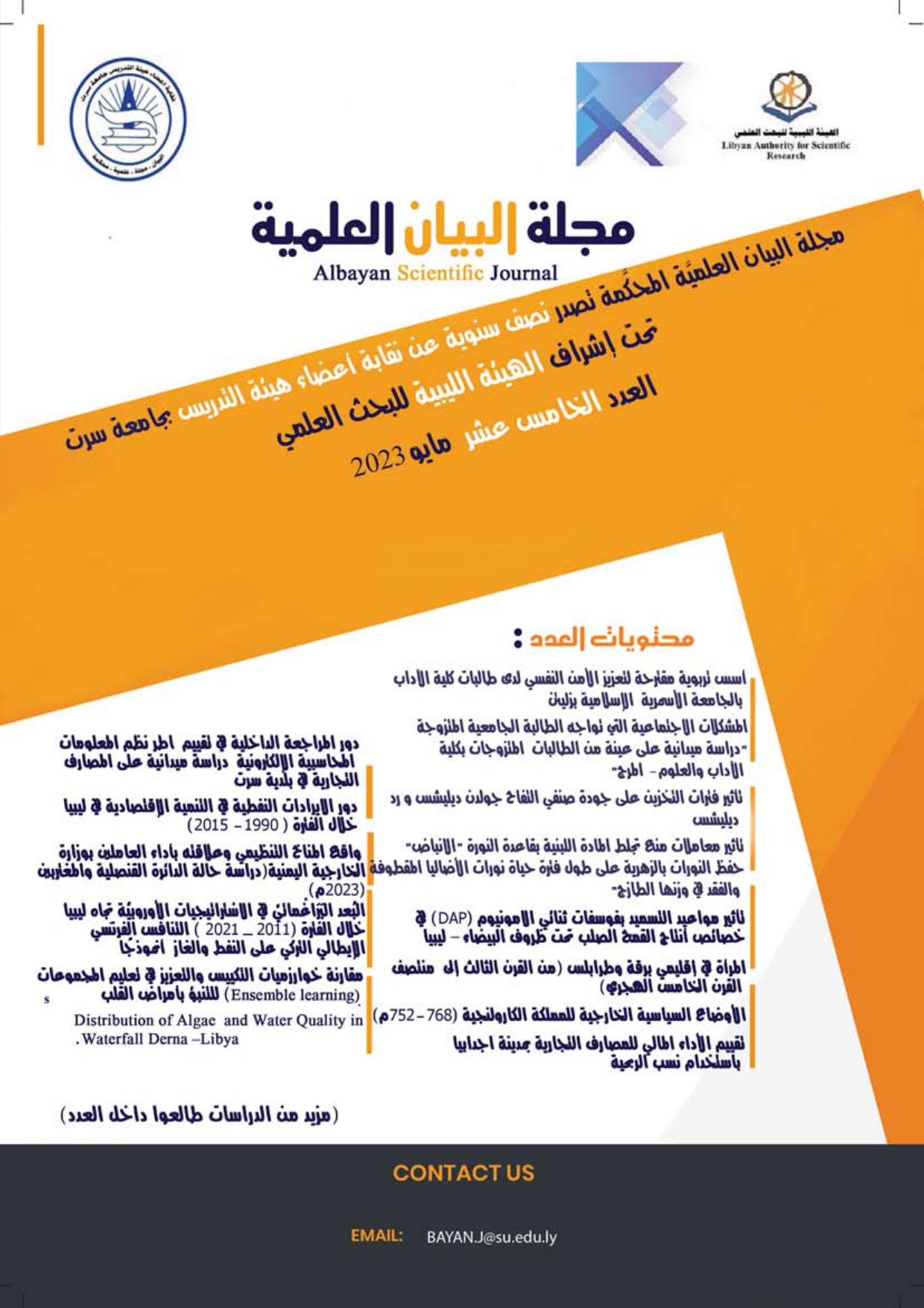توزيع الطحالب وجودة المياه في شلال درنة – ليبيا
DOI:
https://doi.org/10.37375/bsj.vi15.1802الكلمات المفتاحية:
شلال درنة، طحالب المياه العذبة، جودة المياه.الملخص
أجريت هذه الدراسة لمعرفة توزيع أنواع طحالب المياه العذبة من شلال درنة ومن ثم تم حساب جودة نقاء المياه باستخدام مقياس مؤشر Saprobity Index. تم عزل وتحديد 48 نوعًا من الطحالب، 19 نوعًا تنتمي إلى فئة Chlorophyceae، 13 منها تنتمي إلى فئة Bacillariophyceae، 14 نوعًا تنتمي إلى فئة Cyanophyceae واثنان منها تنتمي إلى فئة الطحالب Euglenophyceae. تشير النتائج إلى أن شلال درنة كان غنيًا بتنوع الطحالب خلال مواسم الدراسة، وهذا التنوع يدل على جودة ونقاء المياه.
المراجع
References:
Adam, MS, Mohammed, AA, & Issa, AA. (1990). Physico-Chemical characteristics and planktonic algae of two irrigation canals and a closed pond at Assiut area Egypt. Bull. Fac. Sci. Assiut. Univ, 19(2-D), 219-245.
Affan, Abu, Jewel, Abu Syed, Haque, Mahfuzul, Khan, Saleha, & Lee, Joon-Baek. (2005). Seasonal cycle of phytoplankton in aquaculture ponds in Bangladesh. Algae, 20(1), 43-52.
Aguirre, Julio, & Riding, Robert. (2005). Dasycladalean algal biodiversity compared with global variations in temperature and sea level over the past 350 Myr. Palaios, 20(6), 581-588.
Alshaaki, A. (1996). Assessment of the water situation in Ghadwa area in Murzuq basin. . M.Sc. Thesis. Faculty of Agriculture, Al-Fateh University, Tripoli –Libya.
Andersen, RA. (1992). Diversity of eukaryotic algae. Biodiversity & Conservation, 1, 267-292.
Andersen, Robert A. (2013). The microalgal cell. Handbook of microalgal culture: applied phycology and biotechnology, 1-20.
Aziz, Farhad Hasan, & Rasoul, Balqis Haji. (2016). Thirty two algae new records reported in ponds at gwer sub-district, erbil-Kurdistan region, Iraq. Bulletin of the Iraq Natural History Museum (P-ISSN: 1017-8678, E-ISSN: 2311-9799), 14(1), 27-42.
Bhakta, S, Das, SK, Nayak, M, Jena, J, Panda, PK, & Sukla, LB. (2011). Phyco-diversity assessment of Bahuda river mouth areas of east coast of Odisha, India. Recent Research in Science and Technology, 3(4).
Bischoff, HW. (1963). Phycological studies IV. Some soil algae from Enchanted Rock and related algal species. University of Texas Publication, 6318, 1.
Butcher, RW. (1946). Studies in the Ecology of Rivers: VI. The Algal Growth in Certain Highly Calcareous Streams. The Journal of Ecology, 268-283.
Cameron, RE, Morelli, FA, & Blank, GB. (1965). Soil Studies-Desert Microflora. VI. Abundance of Microflora in an Area of Soil at White Mountain Range, California. JPL Space Programs Summary 37–32, 4, 212-214.
Christensen, Tyge. (1964). The gross classification of algae. Algae and Man: Based on lectures presented at the NATO Advanced Study Institute July 22–August 11, 1962 Louisville, Kentucky, 59-64.
Chu, SP. (1942). The influence of the mineral composition of the medium on the growth of planktonic algae: part I. Methods and culture media. The Journal of Ecology, 284-325.
Cock, J Mark, Sterck, Lieven, Rouzé, Pierre, Scornet, Delphine, Allen, Andrew E, Amoutzias, Grigoris, . . . Badger, Jonathan H. (2010). The Ectocarpus genome and the independent evolution of multicellularity in brown algae. Nature, 465(7298), 617-621.
Coesel, Peter FM. (1983). The significance of desmids as indicators of the trophic status of freshwaters. Schweizerische Zeitschrift für Hydrologie, 45, 388-393.
De Casabianca, M-L, & Posada, F. (1998). Effect of environmental parameters on the growth of Ulva rigida (Thau Lagoon, France).
Delwiche, Charles F. (2007). Algae in the warp and weave of life: bound by plastids. SYSTEMATICS ASSOCIATION SPECIAL VOLUME, 75, 7.
Dresscher, Th GN, & Van der Mark, H. (1976). A simplified method for the biological assessment of the quality of fresh and slightly brackish water. Hydrobiologia, 48(3), 199-201.
EG Bellinger, DC Sigee (2010). Freshwater Algae: Identification and Use as Bioindicators: Wiley-Blackwell, Chichester, West Sussex, UK. 284 pp., ISBN: 978-0-470-05814-5. (Hardback): Springer.
El-Adl, MF. (2006). Phycologycal Studies on El-Salam Canal and Sahl El-Tineh Region–Egypt. Ph D. Thesis, Mansoura University, 1-285.
Elsalhin, H. El and Abobaker, H. M. (2018). Collection and definition of freshwater algae in City of Shahat-Libya. IOSR Journal of Environmental Science, Toxicology and Food Technology 12, 37-41.
Graham, Linda E, Graham, James M, & Wilcox, Lee W. (2008). Algae. 2, illustrated ed: USA: Benjamin Cummings.
Guiry, Michael D, Guiry, Gwendoline M, Morrison, Liam, Rindi, Fabio, Miranda, Salvador Valenzuela, Mathieson, Arthur C, . . . Bárbara, Ignacio. (2014). AlgaeBase: an on-line resource for algae. Cryptogamie, Algologie, 35(2), 105-115.
Hamadamen, AR. (2015). Phycological study of the qandil mountain streams/sulaimani. Master’s thesis, Univ. of Salahaddin-Erbil.
Kant, Shashi, & Anand, VK. (1978). Interrelationships of phytoplankton and physical factors in Mansar Lake, Jammu (J & K). Indian journal of ecology. 134-140.
Kottelat, Maurice, & Whitten, Tony. (1996). Freshwater fishes of Western Indonesia and Sulawesi: additions and corrections: Periplus editions Hong Kong.
Krammer, Kurt, & Lange-Bertalot, Horst. (1991). Süßwasserflora von Mitteleuropa, Bd. 02/3: Bacillariophyceae Teil 3: Centrales, Fragilariaceae, Eunotiaceae.
Kwak, Jung Hyun, Baek, Seung Han, Woo, Yongje, Han, Jae Kab, Kim, Byung Gon, Kim, Oh Yoen, & Lee, Jong Ho. (2012). Beneficial immunostimulatory effect of short-term Chlorella supplementation: enhancement of natural killer cell activity and early inflammatory response (randomized, double-blinded, placebo-controlled trial). Nutrition journal, 11, 1-8.
Leclercq, L. (1988). Utilisation de trois indices, chimique, diatomique et biocénotique, pour l'évaluation de la qualité de l'eau de la Joncquière, rivière calcaire polluée par le village de Doische (Belgique, prov. Namur). Mémoires de la société royale de botanique de Belgique, 10, 26-34.
Lee, RE. (1989). Basic characteristics of the algae. Phycology, 11-21.
Lee, Tom, & Wilde, Louis L. (1980). Market structure and innovation: A reformulation. The Quarterly Journal of Economics, 94(2), 429-436.
Madyan, AB. (1999). A preliminary study on the source of some pollution on groundwater quality in Benghzi City. M.Sc. Thesis. University of Garyounis- Libya.
Mann, David G, & Vanormelingen, Pieter. (2013). An inordinate fondness? The number, distributions, and origins of diatom species. Journal of eukaryotic microbiology, 60(4), 414-420.
Michelutti, Neal, Douglas, Marianne SV, Wolfe, Alexander P, & Smol, John P. (2006). Heightened sensitivity of a poorly buffered high arctic lake to late-Holocene climatic change. Quaternary Research, 65(3), 421-430.
Norton, Trevor A, Melkonian, Michael, & Andersen, Robert A. (1996). Algal biodiversity. Phycologia, 35(4), 308-326.
Olaveson, MM, & Nalewajko, C. (2000). Effects of acidity on the growth of two Euglena species. Hydrobiologia, 433(1-3), 39-56.
Palmer, CM. (1980). The identification, significance, and control of algae in water supplies and in polluted water. Algae and Water Pollution. Castle House Publications Lrd, UK.
Pentecost, A. (1984). Introduction to Fresh Water Algae. Kingprint Limited, Richmond, Surrey, UK.
Phang, Siew-Moi, & Kim-Chong, Ong. (1988). Algal biomass production in digested palm oil mill effluent. Biological wastes, 25(3), 177-191.
Polat, Sevim, & Işik, Oya. (2002). Phytoplankton distribution, diversity and nutrients at the North-eastern Mediterranean coast of Turkey (Karataş-Adana). Turkish Journal of Botany, 26(2), 77-86.
Prescott, GW. (1982). Algae of the West Great Lakes Area, WMC Brown Company Publishers: Dubugue Press, Towa.
Rao, P Sreenivasa, & Parekh, Kalpana S. (1981). Antibacterial activity of Indian seaweed extracts. Botanica marina, 24: 577-582.
Rasool, Saiema, Ahmad, Altaf, Siddiqi, TO, & Ahmad, Parvaiz. (2013). Changes in growth, lipid peroxidation and some key antioxidant enzymes in chickpea genotypes under salt stress. Acta physiologiae plantarum, 35, 1039-1050.
Rippka, Rosmarie, Coursin, Thérèse, Hess, Wolfgang, Lichtlé, Christiane, Scanlan, David J, Palinska, Katarzyna A, . . . Herdman, Michael. (2000). Prochlorococcus marinus Chisholm et al. 1992 subsp. pastoris subsp. nov. strain PCC 9511, the first axenic chlorophyll a2/b2-containing cyanobacterium (Oxyphotobacteria). International Journal of Systematic and Evolutionary Microbiology, 50(5), 1833-1847.
Seckbach, Joseph, & Oren, Aharon. (2007). Oxygenic photosynthetic microorganisms in extreme environments: possibilities and limitations. Algae and cyanobacteria in extreme environments, 3-25.
Tilman, David, Kiesling, Richard, Sterner, Robert, Kilham, Susan S, & Johnson Frederick, A. (1986). Green, bluegreen and diatom algae: Taxonomie differences in competitive ability for phosphorus, silicon and nitrogen. Archiv für Hydrobiologie, 473-485.
Vantkatarman, G.S. (1969): The Cultivation of Algae.The Indian Couucil of Agriculural Research, New-Delhi, India.
Venkateswarlu, V. (1969). An ecological study of the algae of the river Moosi, Hyderabad (India) with special reference to water pollution: I. Physico-chemical complexes. Hydrobiologia, 33, 117-143.
Villadolid, DV, Panganiban, P, & Megia, TG. (1954). The role of pH in pond fertilization. Indo-Pacific Fish Council Proc, 5(11), 109-111.
Wehr, John D, Sheath, Robert G, & Kociolek, J Patrick. (2015). Freshwater algae of North America: ecology and classification: Elsevier.
Welch, PS. (1952). Limnology McGraw–Hill. New York, 5, pp 138 .














